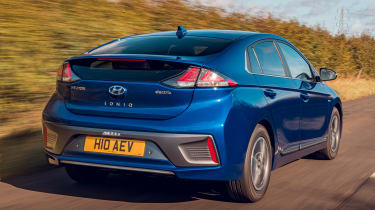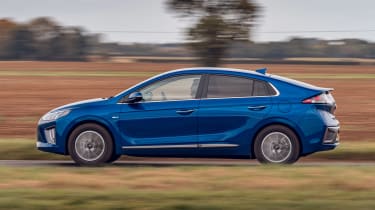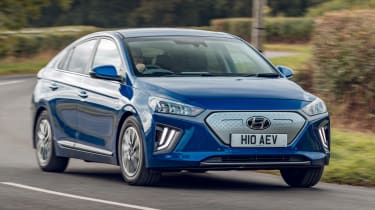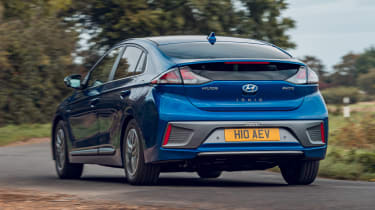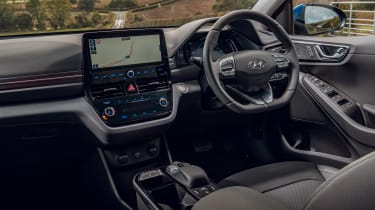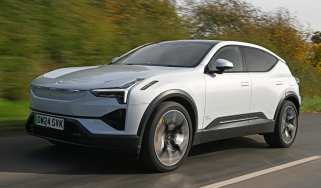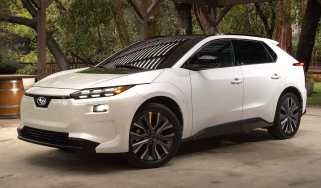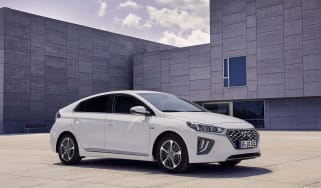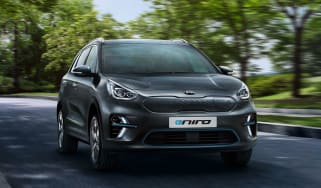Hyundai Ioniq Electric review (2016-2022)
"The Hyundai Ioniq Electric is a zero-emissions family car that's well designed and easy to drive"
Pros
- Low running costs
- Decent practicality
- Enjoyable to drive
Cons
- Expensive to buy
- Forgettable styling
- Limited range, long charging time
Hyundai’s multi-pronged assault on the low emissions car market shows no signs of stopping. It launched the Ioniq in 2016, which became the first car available in the UK offered as a hybrid, plug-in hybrid and fully electric model, and a year later, Hyundai launched its Kona SUV, also in hybrid and electric form. Now Hyundai has updated and improved the Ioniq, and although the Kona Electric still goes further on a single charge, the range of the latest Ioniq should be enough for most drivers’ regular needs.
Despite the updates, the Ioniq is now starting to show its age. Both the facelifted Kona and the excellent Hyundai Ioniq 5 look and feel much more contemporary. The Ioniq 5 may be more expensive but it feels like a next-generation electric car thanks to the latest technology, lots of interior space, cool styling and a maximum range of 298 miles - over 100 more than the Ioniq Electric.
While the Hyundai Ioniq Hybrid and Ioniq Plug-In hybrid competed head on with the Toyota Prius hybrid, Hyundai stole a march on Toyota by offering a pure electric version too. Rivals used to be few and far between but now the Ioniq Electric has to fend off the Volkswagen ID.3, Citroen e-C4 and Nissan Leaf, plus cars like the Peugeot e-2008 and Renault Megane E-Tech.
 The 10 best electric cars in 2025
The 10 best electric cars in 2025
The Ioniq Electric was Hyundai’s first attempt at a full EV. It has decent battery capacity, looks neat and modern, and has an overall form aimed at improving aerodynamic efficiency to reduce wasted energy. It’s a shame it doesn’t have a little more character to set it apart from the crowd, though. Love it or hate it, the Toyota Prius has a stronger identity, while the Ioniq merely looks inoffensive.
Since the hugely distinctive Kia Soul EV comes from the same corporate family, it seems Hyundai deliberately opted for a ‘safe’ look for its first electric model. The same can be said of the interior; while it does little to offend, the Ioniq Electric’s dashboard is entirely conventional and feels barely different to any other comfortable family hatchback. Only a few cosmetic slivers of coloured material break up the mass of grey plastic.
More reviews
The Ioniq seems just as robustly constructed as the Toyota Prius, and should easily withstand the rigours of family life – even if it does fall some way short of the imaginative design on display inside a BMW i3, which is, admittedly, more expensive.
The Ioniq’s fairly conventional design – inside and out – means you’d be forgiven for forgetting that the Ioniq Electric is indeed an electric car. From behind the wheel, the digital range display is one of the few visual reminders that the car doesn’t run on petrol or diesel.
For the facelift, the battery has increased from 28kWh to 38.3kWh but the change from NEDC testing to the new WLTP test means it's hard to compare the range of the older car with the latest version. Suffice to say, the distance you'll be able to drive in real-world is significantly improved, with up to 194 miles possible.
Aside from settling into the routine of charging at home, you needn’t make many compromises to live with the Ioniq Electric, it drives like any other fairly powerful automatic family hatchback. Though it doesn’t have the slingshot acceleration of some other electric cars, it never feels sluggish and is a quiet, relaxing car to cruise in. If you’re not expecting exhilaration, the Ioniq can provide an enjoyable daily drive – we reckon it’s a little more satisfying from behind the wheel than the Hyundai Ioniq Hybrid.
The ultimate deciding factors on whether you go for an Ioniq Electric will be whether you can easily charge at home and if the car seems good value. The Ioniq no longer qualifies for the government's plug-in car grant. but it is still exempt from road tax and the London Congestion Charge.
Compared to most petrol rivals, the Ioniq is quite expensive as family cars go. However, once you factor in the long-term savings you’ll make compared to running a petrol or diesel car, the Hyundai starts to make sense. And company-car users will revel in its lower Benefit-in-Kind (BiK) rating.
MPG, running costs & CO2
From 2019 onwards, the Hyundai Ioniq Electric uses a 38.3 kilowatt-hour (kWh) lithium-ion polymer battery, which is essentially a much bigger version of the battery in your mobile phone - with a longer life expectancy. This is a remarkably lightweight method of storing electricity, certainly compared to the huge banks of lead-acid batteries that propelled milk floats with snail-like urgency in the seventies. Not having to lug a huge amount of weight around is great for efficiency and this is further boosted by the Ioniq’s carefully designed aerodynamic bodywork.
If you park an Ioniq Electric next to a hybrid version of the same car, it doesn’t take long to spot the differences, most prominent of which is the solid front grille. This is solid because there’s no radiator behind it that needs to be kept cool, and because the air that passes through a radiator grille creates wind resistance, blanking it off allows the Ioniq to slip through the air more efficiently.
Hyundai has employed a number of other tricks in the pursuit of efficiency – the car’s climate-control system is specially designed to increase battery life and the wheels and tyres create as little friction and drag as possible, both as they roll over the ground and pass through the air.
All this clever thinking leads to a maximum range for the Ioniq Electric of 194 miles on a full charge. It can be charged from zero to 80% in just over six hours using a 7kwh charger. You can also boost to 80% capacity in just under an hour at a 50kW rapid charging point.
Engines, drive & performance
The electric motor that generates 134bhp (up from 119bhp in earlier cars) and 295Nm of torque is enough to ensure the Ioniq Electric never feels sluggish. The car can accelerate from 0-62mph in 9.9 seconds in Sport mode or 10.2 seconds in its Normal setting. This is some way off the neck-snapping acceleration of some electric cars but enough to make keeping up with traffic easy.
The Ioniq Electric is claimed to be capable of a top speed of 103mph, and while that statistic isn’t necessarily a value on which an electric car will be judged, it does at least suggest that cruising at the legal limit of 70mph will be a stress-free undertaking.
This level of performance puts it head-to-head with rivals including the Nissan Leaf, Kia Soul EV, BMW i3 and Renault ZOE.
When driving around town, we found the action of the brake pedal a little annoying: it seemed inconsistent, sometimes needing more pressure when we didn’t expect it. Fortunately, another efficiency-promoting feature of the Ioniq Electric is regenerative braking setup, which uses the energy of deceleration to charge the battery. Driving carefully, we were able to use this system in place of the regular brakes and only needed to disturb the pedal when pulling to a halt.
On the open road, the Ioniq Electric is an easy and relaxing car to drive, and quite a satisfying one, too. The way the electric motor delivers its power makes light work of accelerating out from tight corners, so it really feels like you’re making swift progress on a country road. The Hyundai feels secure and well planted, too, exhibiting less body lean in corners than the Nissan Leaf.
You don’t get a lot of feel from the steering, though, so you don't always feel connected to what the front wheels are doing. We also found that the steering wheel’s self-centring action was inconsistent – it would sometimes gradually, sometimes suddenly, return to the straight-ahead position after a corner.
Overall, though, the Ioniq acquits itself well on the road. It generally feels like any normal car, but has the advantage of the electric motor’s effortless pulling power. It may not be the most tactile driving experience out there, but it can definitely be relaxing.
Interior & comfort
If you can come to terms with the fact that the Ioniq Electric’s interior lacks much in the way of design flair or imagination, it’s actually a very nice place to be. The dashboard is clear and easy to use, with easily legible dials and controls where you’d expect to find them. A little ambience is added by copper-coloured accents in prominent locations, breaking up the greyness with a bit of visual relief.
It all feels very well put together; many of the materials used are soft-touch and don’t rattle or echo when you make contact with them. You’re not left wanting for equipment, either. The touchscreen infotainment system features Android Auto and Apple CarPlay, as well as a reversing camera and sat nav. If you choose the Premium SE trim level, you get heated and cooled leather seats with a memory function.
On the move, the Ioniq Electric is as quiet as you’d expect a car without a petrol or diesel engine to be. Its low noise helps it to feel particularly soothing around town – although as there’s barely any sound at all as you pull away, you should be extra wary of errant pedestrians or cyclists who haven’t noticed you.
Once up to higher speeds, the Ioniq starts to sound rather more like a normal car – although there’s obviously an absence of engine noise, the roar from the tyres on the road and the rushing of wind on the mirrors and windscreen surround become more noticeable. We found the overall noise comparable to a Toyota Prius and if you turn the radio up, you’ll all but forget the background hubbub.
At these speeds, the ride is especially comfortable, the Ioniq’s suspension taking small lumps in its stride. Slow down and the ride becomes a little stiffer – passengers will definitely feel the impact of drain covers and potholes, but pockmarked urban road surfaces never become intolerable.
Practicality & boot space
The Hyundai Ioniq Electric is a five-seater and most shapes and sizes of passengers should find that it offers plenty of space for a comfortable journey. The sloping roof looks like it could cut into headroom, but we were pleasantly surprised. However, the taller Nissan Leaf does offer a little more space overall for those in the back.
There’s good visibility for all thanks to large windows and slim door pillars. The rear head restraints actually impede rear visibility more than the horizontal bar that divides the rear windscreen – you notice the latter in your rear-view mirror, but it doesn’t have a big effect on overall visibility.
Boot space is comparable with a small family hatchback – at 357 litres, it actually slightly eclipses the Toyota Prius and runs the 380 litres of the Volkswagen Golf hatchback reasonably close. It can be expanded further to 1,417 litres if you fold the rear seats out of use.
Considering that the battery pack sits under the boot floor, this is actually a fairly respectable figure, although it should be mentioned that the charging kit does encroach slightly on the available space. It’s still a usefully shaped load area, though.
Reliability & safety
The Hyundai Ioniq range was a new design from the ground up when it was launched in 2016 and the Ioniq Electric adds a further layer of technology. While this technology was new for Hyundai, the Ioniq became the brand’s best scoring car and the ninth best car overall in our 2020 Driver Power survey. In 2022 the car dropped to 65th overall - still a reasonable result - and scored very highly for running costs.
The Ioniq Electric should also be a very safe car. The standard hybrid Ioniq scored the full five stars when assessed by safety body Euro NCAP in 2016.
Every UK-market Ioniq features seven airbags, automatic emergency braking, adaptive cruise control, blind-spot monitoring, lane-departure warning and a rear cross-traffic alert system to make reversing safer.

